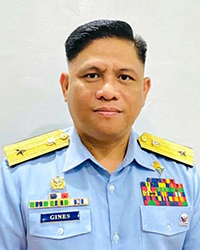
Commodore Marco Antonio Gines
- District Commander, Coast Guard District Southwestern Mindanao and Coast Guard District Bangsamoro Autonomous Region in Muslim Mindanao
- Philippines Coast Guard
An accomplished and renowned trendsetter of excellence, embodying a way of life where excellence is not just an aspiration but a fundamental principle, he has received numerous awards and recognition from various government and civilian organizations for his outstanding performance. He exemplifies the adage that great leaders are made, not born, through a journey of accumulated wisdom from diverse experiences. His trajectory into leadership began at the Philippine Military Academy, graduating proudly with the Class of 1996. His quest for knowledge led him to earn his Juris Doctor degree from Arellano University School of Law and became the inaugural recipient of a Masters in Security Studies, specializing in Homeland Security, from the Naval Postgraduate School in Monterey, California. Renowned for innovation, leading the prestigious Coast Guard Special Operations Group, he introduced pioneering initiatives such as the first female rescue diver course and technical diving in the PCG’s Special Ops. His leadership abilities were further demonstrated in commanding various Coast Guard vessels, earning him the coveted Command-at-Sea badge with two (2) of his ships awarded with “ship of the year” during his incumbency. Advancing through the ranks, he served the Deputy Chief of Coast Guard Staff for Operations (CG-3) and District Commander of Coast Guard District Eastern Visayas before making history by being the first to concurrently command two districts – Coast Guard District Southwestern Mindanao and Coast Guard District BARMM when BARMM area was separated in 2020. He drafted and did much of the leg work as CG-3 for the inclusion of the PCG in the Joint Peace and Security Coordinating Council (JPSCC) leading to PCG’s Co-Chairmanship with AFP and PNP in July 2021. CG Commo Gines’ accolades, including three Bronze Cross Awards and the esteemed Bayani of the Year 2023 Award by UNESCO-World Philosophical Forum, underscore his outstanding contributions.
Sessions
-
Maritime and Big Rivers
Rivers create a particular set of problems for border management. Rivers can flow hundreds and thousands of kilometres from the ocean into national territories. Indeed, rivers make up 23 percent of all international borders.
South America has the largest number of international borders made up by rivers—nearly half. Brazil, Colombia, Venezuela, Suriname, Guyana, French, Guiana, Bolivia, Paraguay, and Uruguay. On the Indian subcontinent the rivers Ganga, Brahmaputra and Indus are shared with neighbouring countries, India Nepal, Bhutan, China, Bangladesh and Pakistan.
As an example of the complexity the Danube can be navigated by ocean going vessels from the Black Sea 2,400 km into the very heart of Europe, passing through or making up part of the border of ten of those countries.
So, how do you manage the intersection of rivers, seas and oceans and the multi-national and multi-jurisdictional complexity of this most challenging of border domains.

